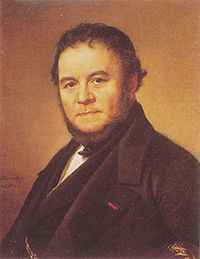Marie Henri Beyle, Stendhal, 1783 – 1842
June 19, 2009
 Marie
Henri Beyle 1783 – 1842,
better known by his pen name Stendhal, was a French writer.
Marie
Henri Beyle 1783 – 1842,
better known by his pen name Stendhal, was a French writer.
Stendhal consulted homeopath G Severin in Berlin, Germany in 1821,
Stendhal was a friend of David Ferdinand Koreff, Mary Elizabeth Clarke Mohl, and Francois Pierre Guillaume Guizot,
The military and theatrical worlds of the First French Empire were a revelation to Beyle. He was named an auditor with the Conseil d’État on August 3, 1810, and thereafter took part in the French administration and in the Napoleonic wars. He travelled extensively in Germany and was part of Napoleon Bonaparte’s army in the 1812 invasion of Russia.
After the 1814 Treaty of Fontainebleau, he left for Italy, where he settled in Milan. He formed a particular attachment to Italy, where he spent much of the remainder of his career, serving as French consul at Trieste and Civitavecchia.
His novel The Charterhouse of Parma, written in 52 days, is set in Italy, which he considered a more sincere and passionate country than Restoration France. An aside in that novel, referring to a character who contemplates suicide after being jilted, speaks volumes about his attitude towards his home country: “To make this course of action clear to my French readers, I must explain that in Italy, a country very far away from us, people are still driven to despair by love.”
Beyle used the pseudonym “Stendhal” (and over 100 others), and scholars in general believe he borrowed this nom de plume from the German city of Stendal in homage to Johann Joachim Winckelmann.
Stendhal was a dandy and wit about town in Paris, as well as an inveterate womaniser who was obsessed with his sexual conquests. His genuine empathy towards women is evident in his books; Simone de Beauvoir spoke highly of him in The Second Sex.
He seems to have preferred the desire to the consummation. One of his early works is On Love, a rational analysis of romantic passion that was based on his unrequited love for Mathilde, Countess Dembowska, whom he met while living at Milan. This fusion of, and tension between, clear headed analysis and romantic feeling is typical of Stendhal’s great novels; he could be considered a Romantic realist.
Stendhal suffered miserable physical disabilities in his final years as he continued to produce some of his best work. As he noted in his journal, he was taking iodide of potassium and quicksilver to treat his syphilis, resulting in swollen armpits, difficulty swallowing, pains in his shrunken testicles, sleeplessness, giddiness, roaring in the ears, racing pulse and tremors so bad he could scarcely hold a fork or a pen.
Indeed, he dictated The Charterhouse of Parma in this pitiable state. Modern medicine has shown that his health problems were more attributable to his treatment than to his syphilis. Stendhal died on March 22, 1842, a few hours after collapsing with a seizure on the streets of Paris. He is interred in the Cimetière de Montmartre.